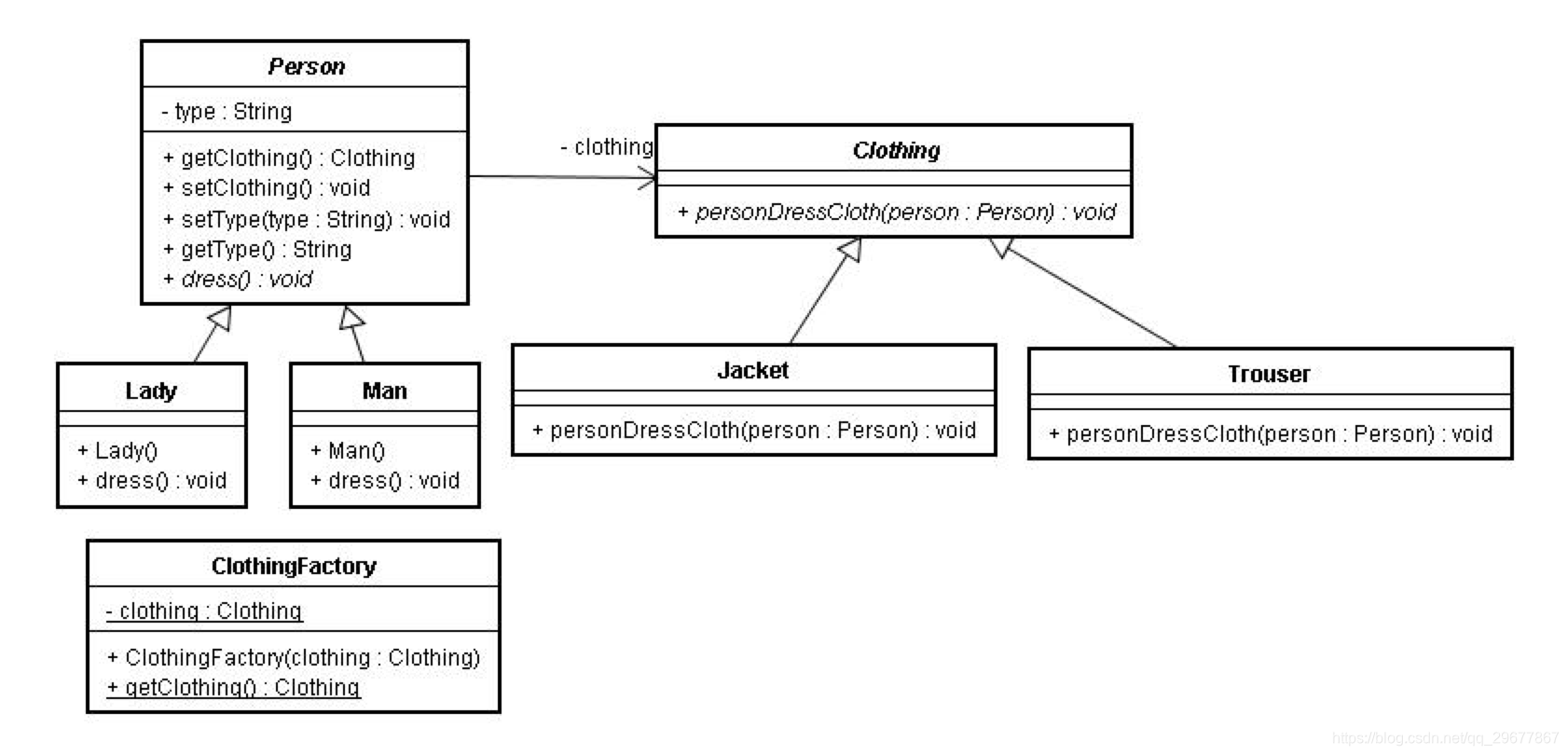结构类型7-2:桥接模式(Bridge Pattern)
1. 概述
桥接(Bridge)是用于把抽象化与实现化解耦,将抽象部分与它的实现部分分离,使它们都可以独立地变化。
这种模式涉及到一个作为桥接的接口,使得实体类的功能独立于接口实现类。这两种类型的类可被结构化改变而互不影响。
我们通过下面的实例来演示桥接模式(Bridge Pattern)的用法。其中,可以使用相同的抽象类方法但是不同的桥接实现类,来画出不同颜色的圆。
2. 介绍
2.1 意图
将抽象部分与实现部分分离,使它们都可以独立的变化。
2.2 主要解决
在有多种可能会变化的情况下,用继承会造成类爆炸问题,扩展起来不灵活。
2.3 何时使用
实现系统可能有多个角度分类,每一种角度都可能变化。
2.4 如何解决
把这种多角度分类分离出来,让它们独立变化,减少它们之间耦合。
2.5 关键代码
抽象类依赖实现类。
2.6 应用实例
1、猪八戒从天蓬元帅转世投胎到猪,转世投胎的机制将尘世划分为两个等级,即:灵魂和肉体,前者相当于抽象化,后者相当于实现化。生灵通过功能的委派,调用肉体对象的功能,使得生灵可以动态地选择。
2、墙上的开关,可以看到的开关是抽象的,不用管里面具体怎么实现的。
2.7 优点
1、抽象和实现的分离。
2、优秀的扩展能力。
3、实现细节对客户透明。
2.8 缺点
桥接模式的引入会增加系统的理解与设计难度,由于聚合关联关系建立在抽象层,要求开发者针对抽象进行设计与编程。
2.9 使用场景
1、如果一个系统需要在构件的抽象化角色和具体化角色之间增加更多的灵活性,避免在两个层次之间建立静态的继承联系,通过桥接模式可以使它们在抽象层建立一个关联关系。
2、对于那些不希望使用继承或因为多层次继承导致系统类的个数急剧增加的系统,桥接模式尤为适用。
3、一个类存在两个独立变化的维度,且这两个维度都需要进行扩展。
2.10 注意事项
对于两个独立变化的维度,使用桥接模式再适合不过了。
1、你不希望在抽象和它的实现部分之间有一个固定的绑定关系。
例如这种情况可能是因为,在程序运行时刻实现部分应可以被选择或者切换。
2、类的抽象以及它的实现都应该可以通过生成子类的方法加以扩充。
这时Bridge模式使你可以对不同的抽象接口和实现部分进行组合,并分别对它们进行扩充。
3、对一个抽象的实现部分的修改应对客户不产生影响,即客户的代码不必重新编译。
4、正如在意图一节的第一个类图中所示的那样,有许多类要生成。
这样一种类层次结构说明你必须将一个对象分解成两个部分。
5、你想在多个对象间共享实现(可能使用引用计数),但同时要求客户并不知道这一点。
3. 参与者
1.Abstraction
定义抽象类的接口。
维护一个指向Implementor类型对象的指针。
2.RefinedAbstraction
扩充由Abstraction定义的接口。
3.Implementor
定义实现类的接口,该接口不一定要与Abstraction的接口完全一致。
事实上这两个接口可以完全不同。
一般来讲,Implementor接口仅提供基本操作,而Abstraction则定义了基于这些基本操作的较高层次的操作。
4.ConcreteImplementor
实现Implementor接口并定义它的具体实现。
4. 类图

5. 例子
5.1 Abstraction && RefinedAbstraction
public abstract class Person {
private Clothing clothing;
private String type;
public Clothing getClothing() {
return clothing;
}
public void setClothing() {
this.clothing = ClothingFactory.getClothing();
}
public void setType(String type) {
this.type = type;
}
public String getType() {
return this.type;
}
public abstract void dress();
}
//RefinedAbstraction
class Man extends Person {
public Man() {
setType("男人");
}
public void dress() {
Clothing clothing = getClothing();
clothing.personDressCloth(this);
}
}
class Lady extends Person {
public Lady() {
setType("女人");
}
public void dress() {
Clothing clothing = getClothing();
clothing.personDressCloth(this);
}
}
Implementor && ConcreteImplementor
public abstract class Clothing {
public abstract void personDressCloth(Person person);
}
//ConcreteImplementor
class Jacket extends Clothing {
public void personDressCloth(Person person) {
System.out.println(person.getType() + "穿马甲");
}
}
class Trouser extends Clothing {
public void personDressCloth(Person person) {
System.out.println(person.getType() + "穿裤子");
}
}
Test
public class Test {
public static void main(String[] args) {
Person man = new Man();
Person lady = new Lady();
Clothing jacket = new Jacket();
Clothing trouser = new Trouser();
jacket.personDressCloth(man);
trouser.personDressCloth(man);
jacket.personDressCloth(lady);
trouser.personDressCloth(lady);
}
}
result
男人穿马甲
男人穿裤子
女人穿马甲
女人穿裤子
6. 示例2
我们有一个作为桥接实现的 DrawAPI 接口和实现了 DrawAPI 接口的实体类 RedCircle、GreenCircle。Shape 是一个抽象类,将使用 DrawAPI 的对象。BridgePatternDemo,我们的演示类使用 Shape 类来画出不同颜色的圆。

6.1 Abstraction && RefinedAbstraction
//创建桥接实现接口。
public interface DrawAPI {
public void drawCircle(int radius, int x, int y);
}
//RefinedAbstraction
//创建实现了 DrawAPI 接口的实体桥接实现类。
class RedCircle implements DrawAPI{
@Override
public void drawCircle(int radius, int x, int y) {
System.out.println("Drawing Circle[ color: red, radius: "
+ radius +", x: " +x+", "+ y +"]");
}
}
class GreenCircle implements DrawAPI{
@Override
public void drawCircle(int radius, int x, int y) {
System.out.println("Drawing Circle[ color: green, radius: "
+ radius +", x: " +x+", "+ y +"]");
}
}
Implementor && ConcreateImplementor
//使用 DrawAPI 接口创建抽象类 Shape。
public abstract class Shape {
protected DrawAPI drawAPI;
public Shape(DrawAPI drawAPI) {
this.drawAPI = drawAPI;
}
public abstract void draw();
}
//ConcreateImplementor
//创建实现了 Shape 接口的实体类。
class Circle extends Shape{
private int x, y, radius;
public Circle(DrawAPI drawAPI, int x, int y, int radius) {
super(drawAPI);
this.x = x;
this.y = y;
this.radius = radius;
}
@Override
public void draw() {
drawAPI.drawCircle(radius, x, y);
}
}
test
public class BridgePatternDemo {
public static void main(String[] args) {
Shape redCircle = new Circle(100,100, 10, new RedCircle());
Shape greenCircle = new Circle(100,100, 10, new GreenCircle());
redCircle.draw();
greenCircle.draw();
}
}
Drawing Circle[ color: red, radius: 10, x: 100, 100]
Drawing Circle[ color: green, radius: 10, x: 100, 100]



